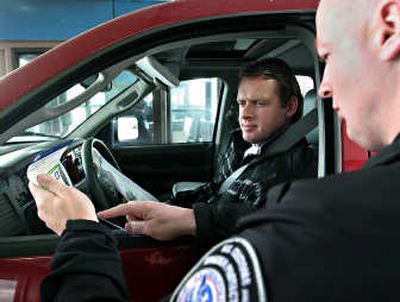Document requirement takes effect at border

BLAINE, Wash. – Some came south from Canada to buy gasoline or groceries, others were bound for the Seattle Boat Show or Las Vegas, a few were on business or family visits.
The vast majority had the necessary papers, and practically all passed through this busy crossing along the nation’s northern border without a hitch Thursday as a new law requiring proof of nationality and identity for U.S. and Canadian citizens took effect.
The Peace Arch crossing is a gateway for those traveling between Seattle and Vancouver, B.C.
By midday 300 to 400 motor vehicles had gone through the crossing without anyone being stopped for failure to have sufficient documentation, said Mike Bol, a U.S. Customs and Border Patrol supervisor.
That was only partly because enforcement of the law is being phased in through June 2009. The main reason is widespread compliance dating from months and in many cases years before the law took effect, especially among regular border crossers who account for most of the traffic in the offseason.
Unless an officer suspects something is amiss – the standard that applied for generations in which a verbal declaration of citizenship was usually enough – anyone at least 19 years old without a U.S. or Canadian passport or a birth certificate and government-issued identification is merely handed a one-page explanation of the new requirements.
“We’re not going to spend a lot of time with people. We’re going to give them a flier and send them down the road,” said Mike Milne, a regional customs spokesman.
A steady stream of Canadians who accounted for the lion’s share of the retail shoppers at Edaleen’s Dairy, a farm north of Lynden, the next town to the east, shrugged off the new law as old hat.
“They didn’t bother us at all. We come down here quite often,” said Carlo Corazza, of Surrey, B.C., who said the use of scanning equipment for electronically encoded ID speeds the process considerably.
“Click, click, and you’re through,” he said.
“It’s something that the world is coming to, and we should be grateful for that,” said Dorothy Spring, of Langley, B.C.
“Maybe it will help stop some of these characters we have had from causing trouble.”
During the noon hour, the peak midweek travel time, the wait was less than 15 minutes and hardly half a dozen cars were waiting in each of the three regular vehicle lanes at the Peace Arch. For pre-approved frequent border crossers with NEXUS passes, there was rarely any wait at all.
Federal officials are counting on compliance to avert long lineups that could snarl cross-border tourism, business travel and commercial shipments, and the goal was being attained well before Thursday, officials said.
For some months, said Thomas Schreiber, a customs spokesman and former supervisor, his experience in Blaine indicated 90 percent were carrying the required documents.